Successful organizations consistently make decisions in the right direction. It does not happen in a vacuum. They have the standard methodologies to help them guide through sensible decision-making. RAPID decision-making is one such methodology for making decisions.
Just to clear a common misinterpretation, there is nothing rapid about RAPID decision-making. Instead, it involves a thoughtful and multi-step decision-making process where each decision-maker is assigned a role. However, it produces rapid results through well-thought-out decision-making.
A RAPID framework is often used by stakeholders for making high-stakes decisions in an organization. Additionally, in this post, we will look at the ins and outs of RAPID decision-making.
What is RAPID decision-making?
RAPID decision-making is a model for organizational decision-making developed by Bain & Company. It involves assigning roles to decision-makers for making decisions.
The acronym RAPID stands for five roles: Recommend, Agree, Perform, Input, and Decide.
According to a study by McKinsey & Company, only 20 percent of respondents say their organizations excel at decision-making. Further, a majority used the time taken in decision-making ineffectively.
The purpose of using the RAPID decision-making is to ensure that key organizational decisions are made collaboratively, not in silos. In this way, all the key stakeholders distribute the responsibility of decision-making, and each stakeholder’s expertise is utilized in decision-making.
RAPID decision-making roles
The RAPID framework covers key roles in the decision-making process. Here is the explanation of each role and what it does:
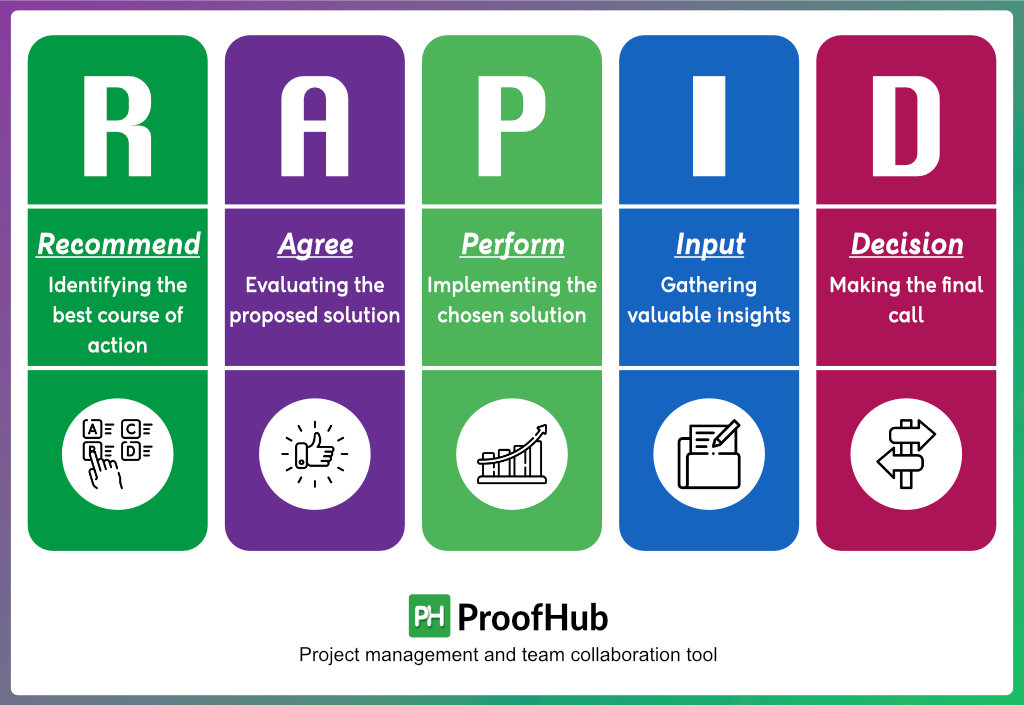
1. Recommend
The ‘recommend role’ is the one who makes recommendations about what needs to be done. Essentially, you can say 80% of the decision-making process happens here. Additionally, a recommender collects the inputs from all the stakeholders involved in the decision-making process, brainstorms, and defines the vision.
Only one recommender is assigned for each decision. The recommender must have the decider’s trust because they develop recommendations for the decider.
2. Agree
The recommender has recommended what to do but it is the responsibility of the ‘agree role’ to define whether or not it is feasible to work on the recommendations. The agreer’s approval is required before passing the final recommendations to the decider.
Multiple stakeholders can be assigned the agreed role. However, it is not necessary to have an agreed role for each decision.
3. Perform
The ‘perform role’ executes the final decision made by the decider. Furthermore, a performer should be able to understand the intent and context of the decision. Additionally, a perform role can be assigned to an individual or team.
In most cases, the performer is also assigned the input role to gather insights. For example, a project manager’s role is to execute the plan, but they can also help during the input stage with a cost-benefit analysis of an initiative.
4. Input
The ‘input role’ provides expertise, insights, and information that shape the recommendation. Additionally, it usually includes all the stakeholders who will be affected by the decision or involved in execution. It helps collect all information and advice to consider throughout the decision-making process. However, not every idea presented in the input needs to be included in the final decision.
5. Decision
The decider is the one who has the final say on everything. He makes the final decision based on the recommendation from the recommender and commits the performer to the action. The decider reviews all relevant data objectively before committing action to recommendations.
The framework of RAPID decision-making
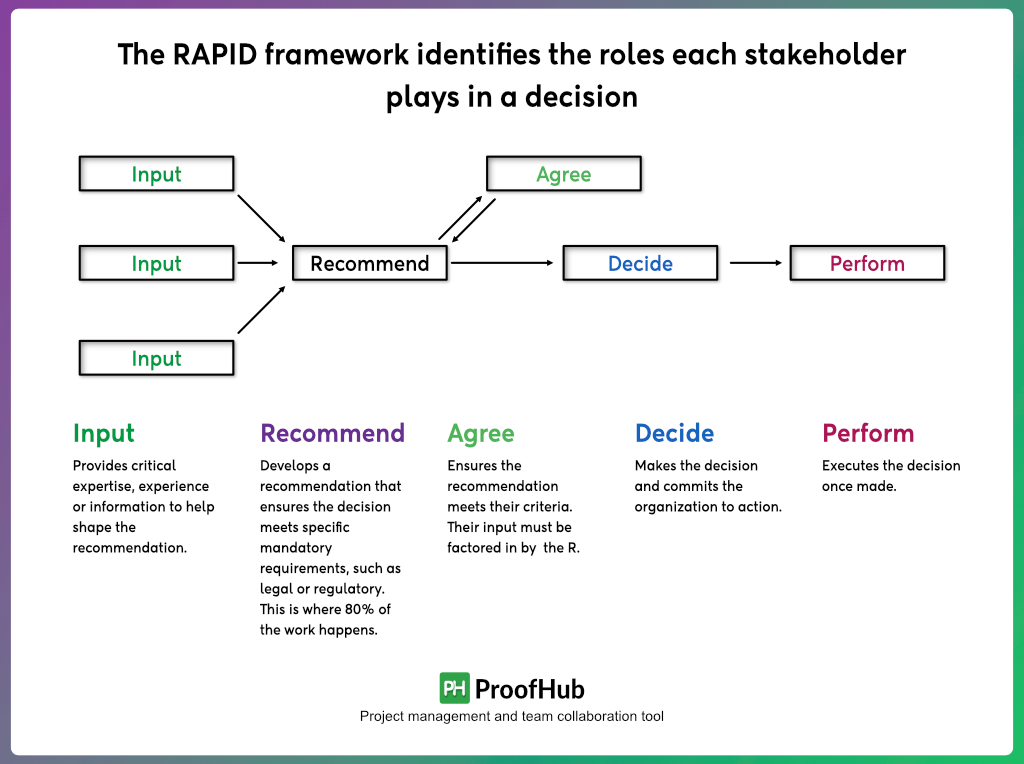
The RAPID framework does not define the order of the decision-making process. It follows the regular order of a decision-making process. The recommendations move from input to perform through recommend, agree, and decide stage.
Here is the workflow of RAPID decision-making:
- First inputs are gathered
- A recommender makes recommendations based on the inputs
- The agreer approves the recommendations
- The agreed recommendations are shared with the decision-maker
- After the final say, the decider passes the recommendations to the performer.
Benefits of RAPID decision-making
RAPID decision-making provides a standard framework for transparent, collaborative, and streamlined decision-making. Have a look at some of the most important RAPID decision-making benefits.
1. More buy-in from all stakeholders
RAPID decision-making increases the buy-in of stakeholders in the initiative. It is because now they are part of the initiative and they do not want to fail.
Also, when everyone is involved in decision-making, they feel more engaged with the work. Resulting in high-quality work on an initiative that achieves the organizational objectives.
2. More expertise and less chance of failure
Having more experts on decision-making teams means involving different perspectives. Consequently, different perspectives lead to spotting more opportunities, planning better for risks, unbiased decisions, and successfully dealing with challenges.
This increases the chances of the success of your decision because now it is covered from all angles. With RAPID decision-making, you put your best foot forward.
3. Increased transparency, enhanced accountability, and fewer conflicts
RAPID decision-making clearly defines everyone’s role. Thus, there is no conflict on ‘who is responsible for what’. This results in increased accountability, streamlined operations, and reduced conflicts. Because now everyone has clarity on their roles and responsibilities.
4. Improved communication and collaboration
RAPID decision-making improves communication by ensuring that all team members are actively engaged in the process. It also encourages collaboration among the team, enabling them to share information effectively with all involved members.
This open communication keeps everyone aligned and fosters a culture of teamwork, ultimately contributing to the achievement of organizational goals.
5. Clear roles and responsibilities
The RAPID framework assigns clear roles to each member involved in the process. This transparency and clarity help reduce confusion and eliminate redundancy in the decision-making process.
Clear roles also enable everyone to focus on their specific responsibilities, which streamlines efforts and helps achieve organizational goals more efficiently and effectively.
Above all, as they are part of the decision, everyone understands the context and intent of the decision which helps in organization-wide alignment to the objectives.
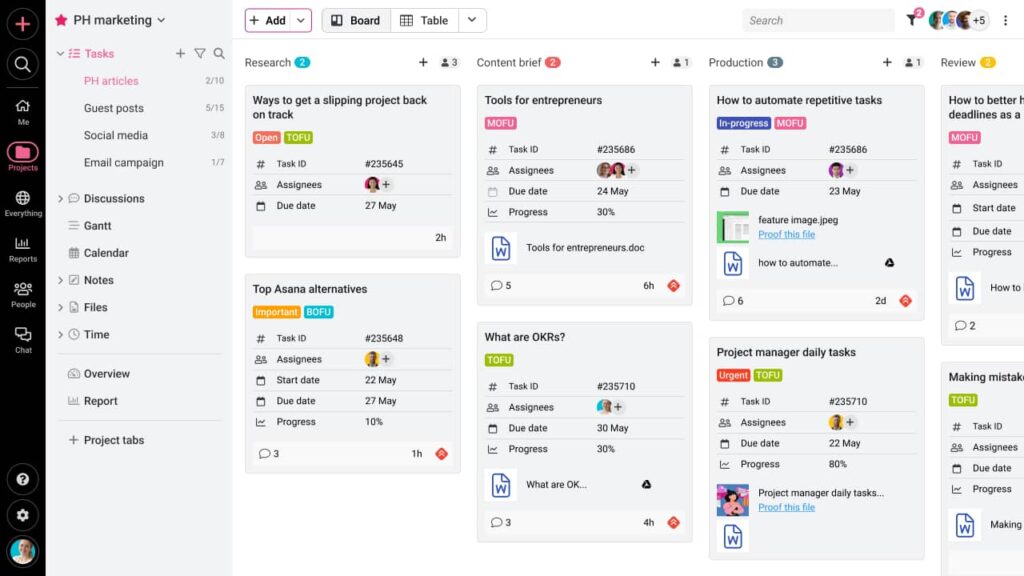
How to implement RAPID framework?
Implementing the RAPID framework is primarily a three-step process. Have a look at the step-by-step process.
1. Identify situations to apply RAPID
You cannot apply the RAPID decision-making process to every situation. However, not every situation demands such detailed, collaborative, and high-stake decision-making. Therefore, identify whether the situation requires the involvement of key stakeholders in decision-making. If yes, go for the RAPID approach.
2. Assign roles and responsibilities
Once you identify the situation and all the stakeholders involved in decision-making, assign the roles and responsibilities using the RAPID framework.
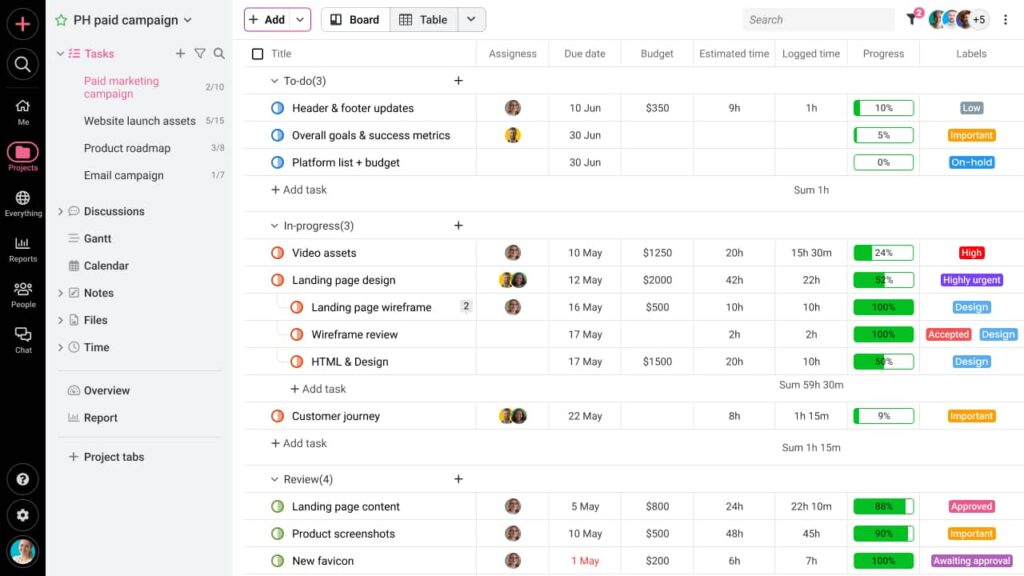
Here is how to assign roles using the RAPID framework:
- Recommend (R): It defines who will analyze the situation and propose the best course of action. This role is often reserved for subject matter experts.
- Agree (A): It defines who has the authority to approve or reject the recommendation. Moreover, this role might be for the heads of the departments who are concerned with decision impact.
- Perform (P): It defines who will take ownership of implementing the decision. This could be an individual or a team with the necessary skills.
- Input (I): It defines who can provide valuable insights and perspectives to inform the decision. Additionally, this might include experienced team members or stakeholders.
- Decide (D): It defines who will ultimately have the final say in the recommendations. This role should have the authority and accountability for the final decision.
Read more: A simple guide to effective task allocation in project management
3. Promote open communication
Implementing a RAPID framework requires effective communication between the RAPID team. Therefore, establishing open channels of communication to encourage seamless communication among the team members is crucial. It helps ensure that every team member’s increased buy-in and expertise can be utilized effectively.
4. Use a collaborative tool
The RAPID model only suggests how to outline each role’s responsibilities. But to implement the framework for a project, you need a collaboration tool.
A Harvard Business Review study found that 85% of employees cited collaboration tools as one of the most critical areas of focus.
Use a project management software like ProofHub to collaborate with a team. It will help you bring all the people, information, and ideas to a single centralized and transparent place.
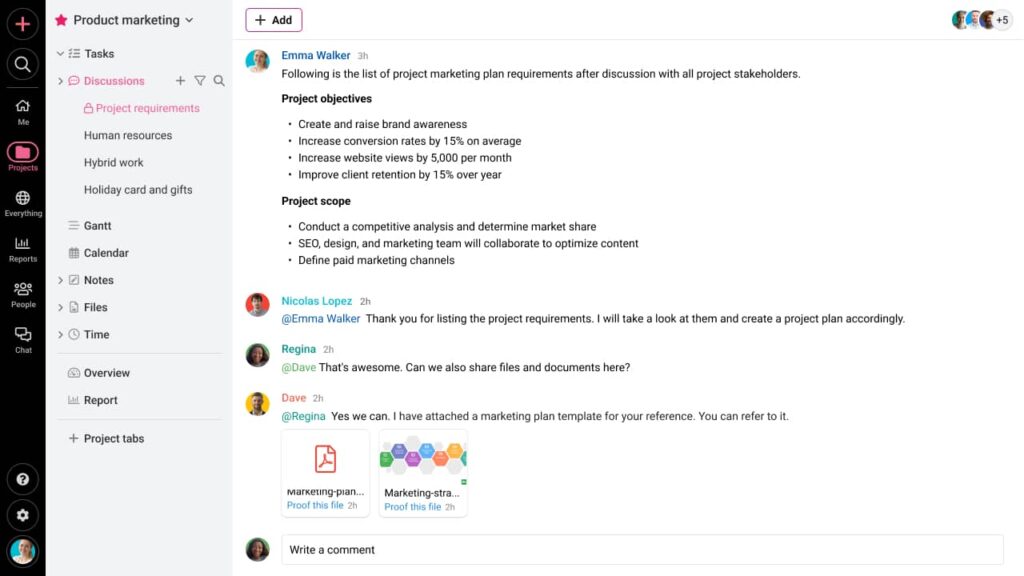
Here is how you can use ProofHub to implement the RAPID framework:
- Create a project, add team members, and set a custom workflow
- Assign a decision-making role to each team member and collaborate with team members to collect inputs using collaborative notes
- Share files with the recommender using centralized file-sharing
- Agreer can use online proofing to make changes to comment on the recommendations
- Use task comments and real-time chat to collaborate with the team
- Convert decisions into tasks, create a project, and set milestones
- Track progress in real-time with reports
Explore ProofHub’s extensive features to learn how you can implement the RAPID framework for decision-making when managing teams and projects.
When to use RAPID decision-making model?
The RAPID decision-making model is ideal for complex projects, where collaborative decisions require stakeholder input and strategic precision. Many readers often end up confusing RAPID decision-making with hasty decision-making, but it is the complete opposite of it. It is a gradual and multi-step process that requires the involvement of multiple stakeholders.
Additionally, a stakeholder can have multiple roles in the RAPID framework or one role can have multiple stakeholders for decision making. Thus, it takes time to collaborate and come to a final mutually agreed decision.
The model of RAPID decision-making focuses on the execution of the strategy at pace. It figures out the ifs and buts of a decision before execution so that there are no challenges due to poor decision-making.
If you want to make quick decisions and seek complete authority, definitely it is not an approach for you. On the other hand, if you are making a high-stakes decision that can impact the company’s offerings, profit, pricing, public image, and culture, RAPID decision-making is the right approach for you.
What is an example of RAPID decision-making?
Take an example of a design overhaul of a company’s website for marketing. Here is what the RAPID framework will look like:
- Recommend: The Marketing Operations Head plays the role of recommender. Furthermore, they will carry out the research and define what changes need to be made.
- Agree: The Chief Financial Officer (CFO), the UI/UX Design Head, and the Head of Legal Compliance act as agreed. It is because they want to ensure that proposed recommendations are profitable, technically feasible, and do not cause any disputes with competitors.
- Perform: The UI/UX manager plays the role of performer. They will plan how to work on the website design overhaul.
- Input: The UI/UX design team, marketing manager, sales manager, and customer success manager will take the role of input. Consequently, they provide different perspectives on what can be included in the design overhaul process.
- Decision: The CEO or the CMO acts as a decider. Additionally, they will approve the final plan of the design overhaul of the website and commit to the action.
This is a RAPID decision example of how collaborative decisions are taken using the RAPID framework.
Challenges in using RAPID decision-making framework
RAPID decision-making comes with a set of challenges. Have a look at them.
- Lack of trust: If you are in a leadership position and running a one-man company, then it is difficult to make decisions using this framework because RAPID distributes the power. The decider has the final say but it is for supporting the decision, not for complete disagreements. The decider must have trust in all the people in RAPID roles.
- Collaborative process: RAPID decision-making is a collaborative, multi-step, and consensus decision-making process. However, you cannot make decisions single-handedly and instantly. Your decision-making team has to be good at collaboration to avoid misunderstandings.
- Involve all the key stakeholders: You need to involve all the key stakeholders. Otherwise, you will miss key insights and expertise which leads to poor decision-making. To successfully implement the RAPID framework, you need strong problem-solving skills and communication skills.
Read more: Master stakeholder management: Your guide to project success
Difference between RAPID and RACI
RAPID and RACI are two different types of frameworks for work and decision management. Both frameworks focus on roles and responsibilities. Here are the meanings and differences:
RAPID focuses on decision-making. It stands for Recommend, Agree, Perform, Input, and Decide. This also helps in assigning the roles and responsibilities who are involved in the process.
RACI stands for Responsible, Accountable, Consulted, and Informed. RACI specifies who is responsible, who is accountable, who should be consulted, and who should be informed. This ensures that tasks are executed effectively and no details are overlooked.
Key Differences:
- RAPID emphasizes decision-making, while RACI is about executing decisions.
- RAPID operates at an organizational level, while RACI works at a project level.
- RAPID addresses planning, while RACI defines the action plan.
RAPID and RACI work well together by covering both decision-making and execution. Together, they help organizations manage everything smoothly, from planning to completing tasks.
Conclusion
Organizations can become more efficient and productive when they improve their decision-making processes. The RAPID decision-making model provides you with a framework to make high-stakes decisions sensibly. Moreover, it helps you streamline your decision-making process, making it collaborative and transparent.
When organizations apply the RAPID decision-making using the right project management skills, the decision-making process becomes easier to understand, streamlined, and more efficient.
With tools like ProofHub, you can collaboratively make decisions, convert them into tasks, track the progress from one central point, and make successful decisions.
Take a 14 -day free trial to see how ProofHub can help you make project decisions.
Frequently asked questions
How does RAPID decision-making differ from traditional decision-making processes?
RAPID decision-making is different from traditional decision-making in terms of clarity of roles and responsibilities. It helps you make decisions quickly because everyone knows what is expected of them. Additionally, it distributes power among stakeholders, leading to collaborative decision-making.
How does the RAPID method improve clarity for decisions and outcomes?
RAPID clearly defines the roles using the acronym RAPID: Recommend, Agree, Perform, Input, and Decide. Consequently, everyone gains clarity about their role and its impact on decision-making.
How does the RAPID approach help teams make quality decisions?
RAPID makes the decision-making process collaborative, transparent, and streamlined. Furthermore, every key stakeholder shares their expertise, and a decision is made after considering various perspectives.

